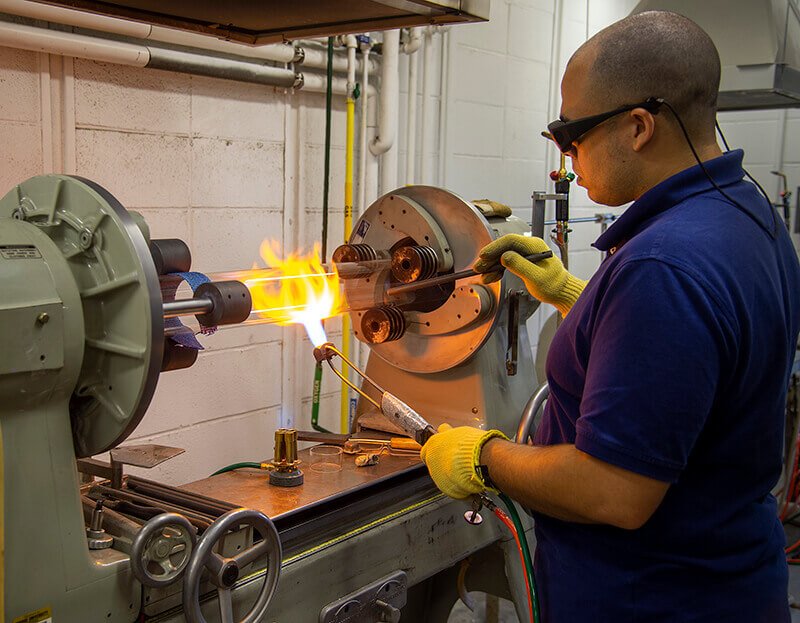Glass Flameworking Lathes and Their Role in Scientific Glassblowing
Glass flameworking lathes play a crucial role in the creation of high-quality scientific glassware. These specialized tools help glassblowers achieve precise and intricate designs that are essential for laboratory equipment. This article delves into the world of glass flameworking lathes, their importance in scientific glassblowing, and the techniques used to produce top-quality scientific glassware.
The Basics of Glass Flameworking Lathes
Glass flameworking lathes are motor-driven machines specifically designed for working with glass tubing and rods. The lathe holds and rotates the glass piece at a constant speed, allowing the glassblower to focus on shaping the glass with various tools and heat sources. The use of a lathe provides greater control, precision, and consistency than can be achieved through manual glassblowing techniques.
Some of the key components of a glass flameworking lathe include:
Headstock: The motor-driven component that provides the rotational force to spin the glass piece.
Tailstock: The adjustable end support that holds the other end of the glass piece and can be moved to accommodate different lengths of tubing or rods.
Lathe bed: The solid base upon which the headstock, tailstock, and other components are mounted.
Chucks: The gripping mechanisms that hold the glass piece securely in place.
Tool rest: A support structure that allows the glassblower to rest their hand or tools during the shaping process.
The Importance of Glass Flameworking Lathes in Scientific Glassblowing
Scientific glassblowing requires a high degree of precision and accuracy to produce functional and reliable laboratory equipment. Glass flameworking lathes are indispensable tools in this field because they provide the following advantages:
Enhanced precision: The constant rotation and support provided by the lathe allow the glassblower to work with greater accuracy, creating uniform walls and precise dimensions.
Improved consistency: The lathe's ability to maintain a consistent speed and position ensures that each glass piece meets the required specifications.
Increased efficiency: Using a lathe enables glassblowers to produce more glassware in less time, as it automates the rotation process and allows for better control of the glass piece.
Greater control: The lathe's support and rotation enable the glassblower to work on intricate designs and delicate connections, essential for scientific glassware.
Techniques Used in Scientific Glassblowing with Glass Flameworking Lathes
There are several techniques and processes that glassblowers utilize when working with glass flameworking lathes in scientific glassblowing:
Sealing and joining: Glass flameworking lathes enable glassblowers to create precise and strong seals between glass pieces, such as connecting a tube to a round-bottom flask. The lathe ensures even heat distribution and accurate alignment, which are critical for maintaining the integrity of the glassware.
Bending and shaping: The lathe's steady rotation allows the glassblower to heat and bend the glass tubing or rods to create complex shapes, curves, and angles required for various scientific instruments. This process involves heating the glass until it reaches a pliable state, then using tools or hand movements to manipulate the shape while the lathe continues to rotate the piece.
Necking and tapering: In scientific glassblowing, it's often necessary to create narrow openings or tapered sections within the glassware. Glass flameworking lathes enable glassblowers to achieve these precise transitions by applying heat to specific areas while continually rotating the glass piece, ensuring even wall thickness and a smooth transition.
Blowing and forming: Glass flameworking lathes can also be used to create hollow forms and vessels, such as flasks, beakers, and distillation apparatus. The glassblower can introduce air into the heated glass piece using a blow hose, causing the glass to expand and form the desired shape. The lathe's rotation ensures even wall thickness and symmetrical forms.
Grinding and polishing: Once the glass piece has been shaped and cooled, the lathe can be used to grind and polish any rough edges or imperfections. The glassblower attaches specialized grinding and polishing tools to the lathe, which work on the rotating glass piece to create a smooth, finished surface.


